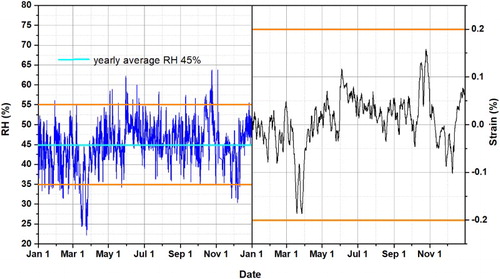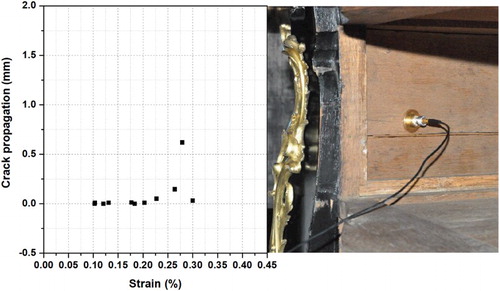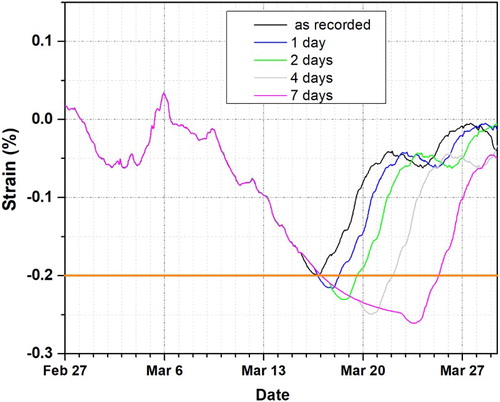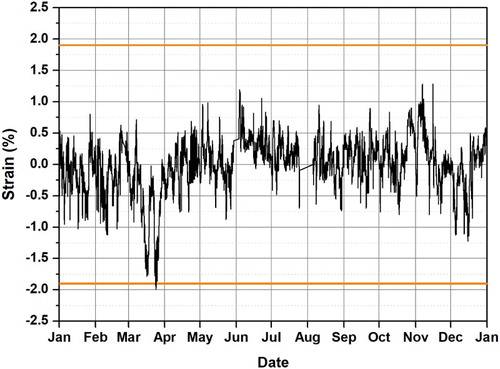ABSTRACT
HERIe is a web-based decision-supporting software tool to facilitate the management of collection environments by precise assessment of climate-induced risk of physical damage to vulnerable objects. The software translates the relative humidity and temperature data recorded in the environment of the analysed object into a strain history experienced by it, and estimates the risk of physical damage using selected failure criteria. As all information is pre-calculated for the user, no engagement in complex and time-consuming numerical simulations is required. HERIe is available for testing at herie.mnk.pl. Detailed information on the methodologies used by the software is available at the above website which also contains tutorial climates. The current work aims at refining HERIe by selecting the damage criteria not only from laboratory studies but also from direct monitoring damage accumulation in objects, especially using the acoustic emission method. The software has been expanded to include moisture-induced response of parchment to support managing environments in libraries and archives.
Introduction
To ensure appropriate indoor environmental conditions in buildings housing collections to maintain high standards of collection care while reducing energy use is currently in the spotlight of cultural heritage institutions worldwide (Staniforth Citation2014). To reduce energy consumption would mean ‘greening’ memory institutions so that they preserve cultural heritage while respecting the natural environment and resources. This attitude has been succinctly summarized in the IIC/ICOM-CC Declaration on Environmental Guidelines (Citation2014):
Care of collections should be achieved in a way that does not assume air conditioning (HVAC). Passive methods, simple technology that is easy to maintain, air circulation and lower energy solutions should be considered. Risk management should be embedded in museum management processes.
However, universal standards can be just a starting point for specifications of environmental conditions addressing individual risks in storage, display and loans of collections, or in preservation of decoration, fittings and finishes in historic buildings, of varying climatic sensitivity and acclimatized to a particular local environment. Moving to variable guidelines requires more evidence-based decision-making, which is time-consuming and often requires engagement in highly-specialised modelling and monitoring of response of objects to microclimatic variations. To overcome the barrier, HERIe – a decision-supporting software tool for a quantitative assessment of risk of physical damage for various categories of cultural objects vulnerable to real-world climates – has been developed by a collaborative effort of several institutions.
The software examines the impact of one-year (or multi-year) temperature and RH microclimate data measured in a given room, or simulated for various climate-control scenarios. Thermal expansion or contraction have a minor effect on the overall dimensional changes of sensitive historical materials as compared to their responses to moisture. Therefore, only yearly or multi-year RH variations are decomposed, in the first step of the HERIe algorithm, into a set of elementary sinusoidal RH cycles of variable amplitude and duration using Fourier transformation. The elementary RH cycles are then translated into elementary strain cycles of the selected object, using the pre-calculated elementary strain cycle database, which constitutes the core of HERIe. In the next step, the full strain-time history of an object is obtained by summing up the elementary strain cycles. It has been verified that the superposition of the elementary strain cycles performed by HERIe is in agreement with the outcome of the full numerical simulation of response of the object to moisture. In the final step of the analysis, the damage criterion is selected by the user and the environmental risk index for the object stored and exhibited in the analysed environment is calculated.
Managing collection environments by precise risk assessment
The HERIe environmental data analysis tool facilitates quantitative assessment of risk of physical damage induced by real-world microclimates, measured or simulated. The software application to managing the collection environments will be illustrated by risk of physical failure of the gesso layer on an unrestrained wooden panel subjected to RH variations recorded in one of the galleries in the National Museum in Krakow (NMK), Poland, in 2013 (). Strain at break of 0.2% was assumed for stiff and brittle gessoes at the RH low- and mid-range, considered the worst case conditions for the gesso’s vulnerability to fracture (Rachwał et al. Citation2012).
Figure 1. Strain vs. time history (right) experienced by a 0.4 mm thick gesso layer laid on a 10 mm, tangentially-cut wooden panel open to a water vapour flow just through the bare wood surface opposite to the painted face, exposed to RH variations (left) in a gallery in the NMK in 2013. It was assumed in the calculations of strain that no internal stresses were present in the object at the long-term average RH of 45%. The ranges of RH and strain, recommended as safe, are marked with orange lines.

The RH variations in the gallery stayed most of the time within the range of 35–55% which can be interpreted as safe for objects containing hygroscopic material (IIC/ICOM-CC Citation2014), however, with one exception. In March, two repeated falls in indoor RH – to below 25% – were recorded due to insufficient humidification by the climate-control system. However, the calculated strain which would be experienced by a gesso layer laid on a wooden panel exposed to such RH variations just stayed below the critical strain of 0.2% during the panel shrinkage induced by the episode and, therefore, the variations were assumed not to involve any risk of gesso fracture for the type of object analysed. The risk index was derived from the strain histories by the HERIe software. When absolute maximum magnitude of strain experienced by the gesso layer did not exceed the critical strain of 0.2%, the risk index was 0. When absolute maximum magnitude of strain experienced by the gesso layer exceeded 0.4%, or double the strain at break, the risk index was 1. The risk index increased linearly between 0 and 1 for maximum strain magnitudes of between 0.2% and 0.4%.
The assessment of the risk of damage to the gesso layer on a wooden panel can be used in analysis of RH variations simulated for what-if scenarios of interest to a museum or other institution. Quick reaction to a failure of a climate control system in a gallery can reduce the damage risk as the RH variations are only damaging to painted wood when they last longer than the response time of the given panel. shows again the shrinkage experienced by the gesso during the first episode of indoor RH in March, 2013 but the actual dimensional change profile is compared with those simulated for prolonged duration of the low RH condition. During the actual episode, RH stayed below 30% between March 15 and 18, and reached its minimal value of below 25% on March 17 at 8 pm. The duration of the episode in the RH data was numerically prolonged by maintaining RH on this minimal level for an increasing number of days. The plots demonstrate that increasing duration of the fall in RH gradually augmented damaging impact as the panel came closer to its full shrinkage in equilibrium with the new dry condition in the environment. The risk index reflecting this damaging impact increased from 0 to approximately 0.3 and allowed those caring for the collection to assess quantitatively the relative risk related to time interval between the failure of the climate-control system and the reaction of the staff dealing with the failure. The response time of objects, specific for each object category, is an important factor for the reduction of the risk of mechanical damage created by the climate control failures. Detailed knowledge of the response on the time of exposure facilitates planning the collection environment management process.
Refining the damage criteria
As discussed above, critical strains of materials, derived from laboratory studies of moisture-related and mechanical properties of wood and gesso, have been used so far in the software to quantify the risk of damage. However, laboratory analyses are predominantly carried out for new materials which do not necessarily reflect the material properties and vulnerability to damage of historical objects which have acclimatized to a particular indoor environment. Additionally, mechanical studies of art and artists’ materials often yield discrete values of thresholds of the environmental variations, whereas in real-world conditions the failure of historical objects visible to those caring for the collection is preceded by the progressive evolution of micro-damage. Therefore, the assessment of risk of damage of objects acclimatized to their long-term storage or display conditions has been increasingly supported by recording climate-induced damage directly in a continuous way or at a specified time interval. The acoustic emission (AE) method, which is based on monitoring the energy released as sound waves during fracture processes in materials, has been particularly successful in monitoring the fracturing intensity in wood (Łukomski et al. Citation2017).
shows magnitudes of crack propagation in wooden elements of the eighteenth-century pieces of furniture monitored for more than one year in the NMK (Strojecki et al. Citation2014) and the Victoria & Albert Museum in London (Pretzel Citation2014) as a function of amplitude for the episodes of restrained shrinkage induced by decreases in the indoor RH. The plot demonstrates that no fracturing occurs for shrinkage strains below 0.2% but also at higher strains the crack propagation is minute for any practical assessment of damage, and could be recorded only owing to the amazing sensitivity and reproducibility of the AE sensors. Studies of fracturing intensity in several wooden objects exposed to larger RH variations in the laboratory further confirmed the observations that climate-induced cracking of wood was minute – that is in the range of mm2 – in historical objects which experienced uncontrolled environments in its past (Łukomski et al. Citation2018).
Figure 3. Crack propagation as a function of shrinkage strain experienced by wooden elements in furniture (left). The data were obtained from the AE monitoring using sensors located close to the tips of the existing cracks (right).

The data collected so far can be interpreted by the ‘acclimatization’ of wood objects monitored to presumably large RH fluctuations in the past which caused fracturing. The existing cracks open and close reducing the stress and the risk of physical damage beyond that already accumulated in the past. Conservation treatments can erase safety margins of objects achieved by their acclimatization to unstable past climates. If cracks in polychrome sculpture, furniture, or panel paintings act as expansion joints relieving stress in the objects, their consolidation may make the objects more vulnerable to climate fluctuations (Michalski Citation2009).
Managing environments in libraries and archives: parchment as a case study
Research into moisture response and mechanics of art and artists’ materials has so far predominantly focused on objects of fine and decorative art. This has been an important drawback when it comes to historical hygroscopic materials relevant to library and archival collections – paper, board, parchment and leather. For example, leather over wooden covers for incunabula or attached with animal glue to boards for book bindings may experience deformation or physical failure because of restraint on its moisture-induced dimensional response. As a further stage of HERIe software development, parchment was encompassed as a library material particularly vulnerable to moisture which can be regarded as the worst case concern guiding requirements for safe environmental conditions for the library and archival collections.
In , the experimental data for moisture-related swelling of four samples of historical parchment are compared with average strain vs. RH relationship for parchment obtained by fitting the entire set of data to the second order polynomial of the form: strain in % = 1.0335 × 10−1·RH – 3.796 × 10−4·RH2. The measurements were done in two perpendicular directions in each sample to take into account the possible effect of collagen fibre preferred orientation, and the larger response was considered. The yield strain of parchment – that is to say the strain beyond which parchment undergoes permanent deformation – was determined as the upper limit of the elastic range in the stress-strain curves recorded in the laboratory. The deformation coincided with the point where the curve began to deviate from the straight line. The average value of 1.9% was obtained from the measurements in the RH range between 20% and 90% which encompasses conditions of interest for the preservation of library collections indoors, as at low RH parchment dehydrates and becomes brittle and at high RH risk of mould growth increases (Wess and Orgel Citation2000). The rate of water vapour uptake or release by parchment is high when compared to the duration of RH fluctuations – the new equilibrium moisture content in the material is established on an RH change in less than one hour. Therefore, RH variations were translated into the strain vs. time history by assuming that parchment reaches its full dimensional response at each instant of the variation. The strain of parchment calculated for the RH variations illustrated in very slightly exceeded the critical strain of 1.9% during the shrinkage induced by the drying episodes in March 2013. During these episodes, therefore, parchment sheets restrained in their movement by mounting into a rigid protective system or attachment to boards of a book binding may undergo excessive tensile strain and deformation ().
Conclusions
A web-based decision-supporting software tool HERIe aims at gathering growing experimental evidence on the environmental response of historic materials and objects so that precise assessment of risk of climate-induced physical damage is facilitated for conservation and museum community. The HERIe software is an open-source tool – with progress in research, the data base of the cultural heritage objects analysed will be enlarged and the modelling algorithms refined. Further damage monitoring on freshly treated/consolidated objects is necessary to refine the damage criteria available in the software as such objects maybe particularly vulnerable to RH variations. In particular, scarce data on critical strains are available for library and archival objects. Therefore, monitoring of moisture-induced deformation of historical parchments is necessary to refine the damage criteria used by the software.
HERIe is available for testing at herie.mnk.pl. Detailed information on the methodologies used by the software is available at that website which also contains tutorial climates. Conservation professionals, researchers, scientists and decisions-makers are encouraged to test the tool. The feedback gained from the users is vital for its continuous development of the tool.
Disclosure statement
No potential conflict of interest was reported by the authors.
ORCID
Marcin Strojecki http://orcid.org/0000-0001-6411-1306
Łukasz Bratasz http://orcid.org/0000-0002-5277-2606
Roman Kozłowski http://orcid.org/0000-0002-6841-7916
Additional information
Funding
References
- Bratasz, Ł. 2013. “Allowable Microclimatic Variations for Painted Wood.” Studies in Conservation 58: 65–79. doi: 10.1179/2047058412Y.0000000061
- IIC/ICOM-CC. 2014. Declaration on Environmental Guidelines. IIC. Accessed October 6, 2017. http://www.iiconservation.org/node/5168.
- Łukomski, M., V. L. Beltran, F. Boersma, J. Druzik, A. Freeman, M. Strojecki, and T. Learner. 2018. “Monitoring Acoustic Emission in an Epidemiological Pilot Study of a Wooden Object Collection.” In Preventive Conservation: The State of the Art, edited by A. Nevin, J. H. Townsend, M. Strlič, N. Blades, D. Thickett, and J. Kirby Atkinson, S181–S186. London: IIC.
- Łukomski, M., M. Strojecki, B. Pretzel, N. Blades, V. L. Beltran, and A. Freeman. 2017. “Acoustic Emission Monitoring of Micro-Damage in Wooden Art Objects to Assess Climate Management Strategies.” Insight 59: 256–264. doi: 10.1784/insi.2017.59.5.256
- Mecklenburg, M. F., C. S. Tumosa, and D. Erhardt. 1998. “Structural Response of Painted Wood Surfaces to Changes in Ambient Relative Humidity.” In Painted Wood: History and Conservation, edited by V. Dorge and F. C. Howlett, 464–483. Los Angeles: Getty Conservation Institute.
- Michalski, S. 2009. “The Ideal Climate, Risk Management, the ASHRAE Chapter, Proofed Fluctuations, and Towards a Full Risk Analysis Model.” In Proceedings of Experts’ Roundtable on Sustainable Climate Management Strategies, edited by F. Boersma. Los Angeles: Getty Conservation Institute. Accessed October 6, 2017. http://www.getty.edu/conservation/science/climate/climate_expertsroundtable.html.
- Pretzel, B. 2014. “[Un]Reasonable – Broadening Acceptable Climate Parameters for Furniture on Open Display.” In ICOM-CC 17th Triennial Meeting Melbourne Preprints, edited by J. Bridgland, art. 1507, 10 pp. Paris: ICOM. http://icom-cc-publications-online.org/PublicationList.aspx?search=&wg=0&vy=Melbourne+2014&t=0&page=1.
- Rachwał, B., Ł Bratasz, L. Krzemień, M. Łukomski, and R. Kozłowski. 2012. “Fatigue Damage of the Gesso Layer in Panel Paintings Subjected to Changing Climate Conditions.” Strain 48: 474–481. doi: 10.1111/j.1475-1305.2012.00844.x
- Staniforth, S. 2014. “Environmental Conditions for the Safeguarding of Collections: Future Trends.” Studies in Conservation 59: 213–217. doi: 10.1179/2047058414Y.0000000142
- Strojecki, M., M. Łukomski, L. Krzemień, J. Sobczyk, and Ł Bratasz. 2014. “Acoustic Emission Monitoring of an Eighteenth Century Wardrobe to Support a Strategy for Indoor Climate Management.” Studies in Conservation 59: 225–232. doi: 10.1179/2047058413Y.0000000096
- Wess, T. J., and J. P. Orgel. 2000. “Changes in Collagen Structure: Drying, Dehydrothermal Treatment and Relation to Long Term Deterioration.” Thermochimica Acta 365: 119–128. doi: 10.1016/S0040-6031(00)00619-5



